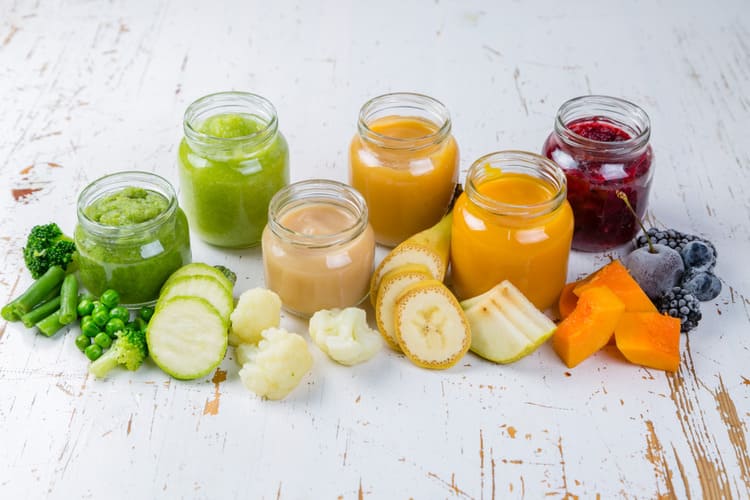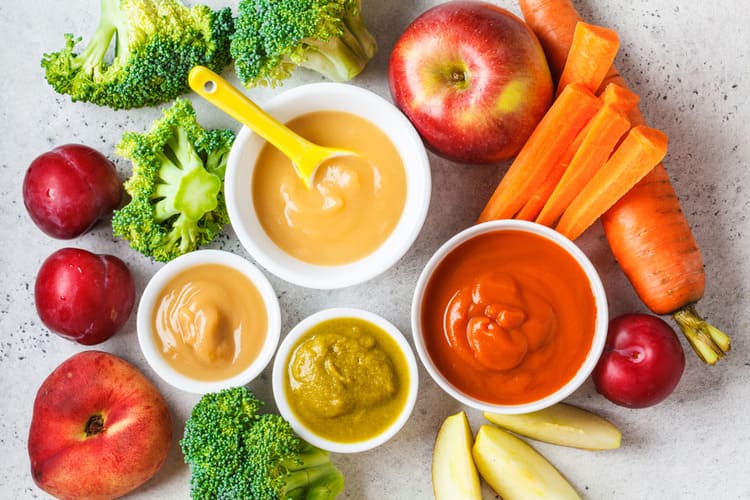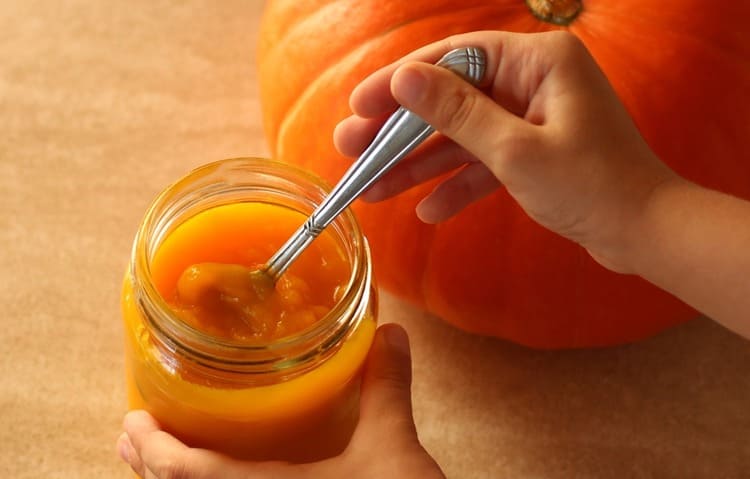
Introduction of complementary foods. First foods from the 4th month - recipes
In the first days, weeks and months, babies are dependent on a single form of food, namely mother's or artificial milk. This raw material provides them with all the necessary nutrients for healthy growth and development. However, after a certain time, the child reaches a developmental phase in which the unexplored world of new foods and the first foods created from them comes into play. This period is also characterized as preparation for gradual weaning of the child from mother's milk.
- When to start solid foods?
- How to start with snacks?
- The number of side dishes should be gradually increased
- Advantages and disadvantages of first foods
- When to include a fruit side dish in the menu?
- Problems in the introduction of baby food
- The first side dishes and recipes for their preparation
- Experiences
- The most frequent questions - FAQ
- Comments
In our article, we present the most important information regarding the phased introduction of complementary foods for babies, while we focus mainly on the time horizon of introducing a new menu and ways to introduce complementary foods into a child's diet. We will also specify how many snacks a 5-month-old or 7-month-old child should eat during the day. As a bonus, we also add some practical recipes for popular and healthy first foods.
When to start solid foods?
Many first-time mothers who find themselves in a very hectic, uncertain and patience-demanding period of their lives ponder this question. So when is it necessary to start introducing complementary foods? In addition to full breastfeeding with mother's milk, it is enough to start preparing the first complementary foods for breastfed babies when the baby reaches six months. In this period, the first, exclusively milk stage ends, when the newborn gets used to life outside the mother's body, and the so-called a transitional stage of development in which new ingredients are included in the child's menu. It is important to always protect the child from the supply of protein in the form of cow's milk.
However, if it is a child receiving artificial nutrition earlier, and thus is not dependent only on breast milk from the first months, it is advisable to start feeding after the end of the fourth to fifth month of the child's age. The justification can be found in the insufficient amount of nutrients contained in artificial milk compared to mother's milk, which means that the child has to start getting used to the new diet earlier in order for his proper and healthy development to occur.
The most suitable moment, which must be fully utilized for the introduction of the first solid foods, occurs in most cases with half-year-old babies. It is the period of life when they begin to be more and more sensitively interested in the world around them, paying extreme attention to their mother while eating, thereby developing a taste for the same food that she takes. It is this period that opens up the opportunity to include snacks in the child's diet.
After the first "feeding sessions", the baby may still be hungry, which means that he will demand milk, which, of course, should be given to him without any worries about digestive problems. A very important factor in the inclusion of snacks in the baby's diet is his ability to move individual pieces of food in his mouth, but also to chew and swallow, so he must have developed mouth and tongue muscles. It is also essential that it can sit (even with support) and control head movements. If the child does not have these skills, it is not completely safe to introduce the first solid foods. It is therefore always necessary to adapt the diet to the level of the child's development.

How to start with snacks?
The correct introduction of the first complementary foods has its own rules, which can greatly influence the baby's attitude to a diet that does not include breast milk or artificial milk. It is convenient and ideal to introduce the first side dishes to the menu instead of lunch in the form of vegetable side dishes. Gradually, however, it is possible to replace evening breastfeeding with milk or non-milk porridge, which satiates the child adequately and eventually puts him to sleep.
So that the child does not develop an aversion to the food served in the future, he should never be forced to eat. It is possible to achieve much better results with gradual and gentle prompting. Another important rule related to the beginnings of complementary feeding is the use of a baby spoon, which, however, should not be licked during feeding, in order to avoid the unwanted transfer of bacteria and viruses to the baby from our oral cavity.
It is advisable to prepare the first vegetable side dish in the form of a puree without lumps, so that the child does not develop an aversion to it precisely because of the lumpy consistency of the food. It is very important that at the beginning of the introduction of complementary foods, this meal consists of only one type of vegetable. It can be, for example, carrots, which are used most often, but also parsley, pumpkin, zucchini, broccoli, cauliflower, eggplant, kohlrabi, peas, parsnips, fennel and potatoes. However, nitrates, which are a possible source of poisoning for babies, should be avoided. These are found in the depths of broccoli, but also in unripe, green potatoes, while care must also be taken to regulate the amount of spinach served to a small child.

Introduction of complementary foods with a three-stage system
There is a so-called a three-stage system, on the basis of which it is possible for the child to get used to a new diet more easily. The introduction of complementary foods therefore consists of three steps, which can take a different length of time for each baby.
The first level of this system consists of a one-component side dish, which means that breastfeeding at lunch time is gradually replaced by a menu in the form of a side dish made from one type of vegetable. It can be, for example, carrot puree. Such complementary feeding works on the principle of a stepwise daily increase in the amount of food served with the aim of completely replacing lunchtime breastfeeding with complementary food. During the entire process, it is necessary to stick to one type of vegetable, while in the case of an allergic or other reaction of the child to the selected vegetable, it is necessary to replace it with another, so that the baby's digestive system is relieved. However, such a problem can also be solved by moving the plan to introduce the first complementary foods to a later period.
If the child has become accustomed to a one-ingredient lunch menu in the form of a vegetable side dish, another type can be added to the primarily chosen vegetable after some time. It is therefore the second step, i.e. the introduction of a two-component supplement, while this habit also needs to be strengthened again for a period of several days, since the whole principle of the three-step system consists in constancy and persistence.
In the third system stage, another new ingredient is added to the puree made from the two selected types of vegetables. It can be another variety of vegetables, or meat, but also a boiled egg, while only the yolk is used due to the high content of allergens in the white. In connection with meat, it is advisable to choose lean beef or veal, although chicken, turkey or rabbit meat will also provide the child with healthy nutrients.
Patience and persistence is a very important factor for all systemic stages, as initially it is considered a very positive result if the child even accepts one to two teaspoons of prepared food. From the point of view of food preparation, it is necessary to point out that vegetables, as well as meat, should be taken by the child in a non-spicy and unsalted form.

The number of side dishes should be gradually increased
At the beginning of the introduction of complementary foods, the plan for breastfeeding or giving artificial milk remains in its original state, while complementary foods must be introduced to the child gradually. Initially, the child's diet should consist of one side dish, while the remaining meals of the day are made up of the original infant plan. This is mainly due to the fact that a full dose of regular complementary food is 150 grams, which the child will definitely not eat at first, and therefore the necessary dose must be supplemented with breast milk or artificial milk.
Lunch is the most ideal meal for initial feeding, while it is possible to gradually replace evening breastfeeding with milk porridges in the form of easily digestible and filling alternatives, such as gluten-free rice or corn porridge. Milk itself needs to be added to some types of porridge. The advantage of dairy and non-dairy porridges is their ability to satiate the baby so much that the feeling of a full stomach keeps him in the realm of dreams for much longer, which also gives the mother the necessary time to sleep. When buying porridge, it is necessary to pay attention to the composition, because the excessive content of sugar, chocolate or fruit can cause the exact opposite, which means that you will inadvertently give the child more energy than you originally planned.
If the child is able to eat at least 50 grams of the prepared side dish at a sitting without any problems or objections, another course can be added to his diet, while the procedure for introducing this side dish is the same as for the first. However, it is important to maintain at least a three-hour gap between two meals. A child who is regularly breastfed and also receives food in the form of snacks at least twice a day does not need to be given water or tea, as breast milk alone covers the necessary amount of fluids.
According to the ideal feeding plan, four- to six-month-old children should receive at least one solid food a day, while after reaching half a year, babies receive two to three meals in the form of solid food during the day. It can be, for example, lunch and snacks, while other meals are made up of milk in the form that the mother has. The third period in terms of the time horizon for the introduction of the first solid foods begins a quarter of a year before reaching the first year of life. This phase is characterized by the gradual habituation of the child to the regular diet of adults, but at this stage it is still specially adjusted for the needs of the developing child.

Advantages and disadvantages of first foods
As we mentioned above, among the first foods introduced into a child's diet are vegetable and dairy foods, or non-dairy porridge. Both of these alternatives have their advantages and disadvantages, but let's elaborate a little more. Vegetable side dishes are, of course, very healthy and rich in nutrients, but they are also suitable candidates for the initial introduction of side dishes, because in this way the child is first introduced to less pronounced tastes without sweeteners and only then to the more interesting tastes, from which it was difficult to get vegetables if the mother chose the opposite approach.
The disadvantage of vegetables and side dishes made from them is the difference in taste from milk, which initially the child receives as the only form of food. This very fact often causes problems when introducing the first solid foods into the baby's diet. Unlike vegetable side dishes, they have dairy or non-dairy porridge tastes closer to mother's milk, which facilitates the transition of the child to a new diet . However, such porridges have a considerable sweetness, which can later complicate the child's gradual habituation to various types of vegetables and other unpleasant-tasting foods.
When to include a fruit side dish in the menu?
In the event that the child is already used to milk, or non-dairy porridges, vegetable side dishes, or combinations of vegetables with meat, you can gradually start introducing single-type alternatives to fruit side dishes . The principle of the gradual introduction of a new menu is basically the same as in the case of the first vegetable side dishes. So start with one type first and gradually add others to the side dishes you are preparing. Initially, it is important to stick to classic and especially easy-to-digest fruits, such as a banana or an apple.
It is more difficult for babies to get used to sour and exotic fruit varieties, so you should try to introduce snacks made from less typical fruits only after the child celebrates his first year of life. Just as in the daily menu of adults, fruit appears in the position of the morning snack or breakfast, babies should also be served fruit snacks at that time.

Problems in the introduction of baby food
The period of introduction of the first solid foods can be very complicated and demanding. Of course, it depends on the baby itself, since even in this case, each case is individual. The intake of new food can first of all cause complications related to the child's digestive system, which is very sensitive, especially in the form of constipation. Therefore, it is not unusual if your baby does not produce solid stools at the beginning of the process of introducing solid foods. This aspect, as well as any other reactions of the child's organism to the given food, must be carefully observed.
The most common problem is the refusal of snacks that you want to get the baby used to. In such a case, postpone the process of introducing the first complementary foods even for a month, so that the child does not inadvertently oppose such a diet before he has properly tasted it.
The opposite is the case for children who get so used to the new tastes of their first vegetable snacks that they begin to refuse breastfeeding. However, as we have already mentioned, maternity or artificial milk remains a very important source of nutrients even in the period of gradual introduction of complementary foods. In case of refusal of milk, proceed to breastfeeding in the morning or in the evening, when the child is in a state of fatigue and therefore does not have the opportunity to produce enough energy to protest.
Some children are picky at the beginning of getting to know a new diet in the form of snacks, and thus they may show a dislike for the lumpy consistency of mixed vegetable purees and porridges. Even in this case, it is therefore true that you should move the introduction of complementary feeding to a later period in the near future in your time plan. It is necessary to remember that patience is key during the introduction of the first foods.
The first side dishes and recipes for their preparation
In stores today, you can find a wide selection of different types of baby food, but home-prepared food is more suitable for both adults and babies, and in some aspects, an irreplaceable alternative. If moms want to avoid the unnecessary stress of preparing fresh vegetable side dishes every day, they can prepare them in larger quantities several months in advance, and just store them according to the same principle as preserves. In this way, the pre-prepared dish will retain its original freshness.

Preparation of a side dish with beef (or other) meat
The general instructions for preparing side dishes with meat consist of properly washing, cleaning and cutting the selected type of meat into small cubes. It is necessary to boil these pieces of meat in baby water for a few minutes, after which it is good to stew them in olive oil. There is no need to overdo it with a lot of baby water or olive oil. It should also be noted that spices, salt and similar meat flavorings prepared for infant formula, which are attractive for adults, definitely do not belong in health terms.
After finishing the heat treatment of the meat, it is enough to fry it in the same way as cooked vegetables, to which the meat mix is mixed. To supply the necessary nutrients, it is advisable to add a hard-boiled egg yolk to the vegetable mix once a week, while it is important to mention that egg white should be avoided when preparing baby food until it reaches the first year of life, due to its high content of allergens.
Eggplant side dish
Eggplant needs to be properly washed, cleaned and cut, while heat preparation over steam is recommended to preserve as much nutrients and vitamins as possible. After that, it is enough to pop the cooked eggplant and mix it so that the eggplant side dish takes the form of a puree. If the puree seems too thick, it can be diluted with the baby water in which the vegetables were cooked. This instruction for preparing a simple eggplant puree can be used to prepare any other vegetable side dish of your choice and discretion.
Recipes for side dishes from the 4th month
As we mentioned above, from the fourth month, children should receive their first side dish consisting of at least one vegetable, while some babies who get used to it more quickly will also welcome two-ingredient dishes.

Pumpkin side dish with sweet potatoes
Just like the aubergine alternative mentioned above, the pumpkin side dish with sweet potatoes consists of steaming the vegetables. A handful of pumpkin cubes and half a sweet potato are enough for one dose. It is also a good idea to cut the potato to speed up its cooking process. All you have to do is mash the vegetables in 125 milliliters of boiled baby water and add a drop of olive oil to it.
The first side dish of zucchini and carrots
In the same way, steam 1 carrot and a handful of diced zucchini, while you can also add about 20 grams of stewed chicken to this vegetable mix, based on the stage of introduction of complementary foods in which your child is. Mash all the ingredients with boiled baby water and add a drop of olive oil to the prepared puree.
Recipes for snacks from the 6th month
Some babies already from the sixth month receive specially prepared imitations of the diet for adults quite normally. In the next few paragraphs, you will find some practical recipes to make your child's diet special.
Side dish in the form of tomato puree
First of all, it is necessary to boil and peel at least 2 to 3 ordinary tomatoes. By popping them, you can prepare a puree, to which you only need to add approximately 2 spoons of rice porridge. Add 1 to 2 tablespoons of plain yogurt to soften. In the best case, it should be organic yogurt, or white yogurt without cow's milk.

Vegetable risotto
Just like when preparing an alternative for adults, risotto for babies needs to be started by cooking a handful of rice. While the rice is cooking, prepare the vegetables of your choice, preferably carrots, peas, corn and one broccoli floret. All you have to do is mash all the vegetables, drizzle with olive oil and mix with the cooked rice.
Broccoli soup side dish
Mix the baby water with the cornmeal to make a thin slurry, which you then pour into the soup in which 100 grams of broccoli are gently cooked. Boil them together for five minutes, then let them cool a little and mix them using a piece of butter or a little milk.
Red lentil side dish
Peel 2 tablespoons of red lentils, grate 1 cup of carrots, chop 1 cup of leeks, then add all the ingredients to the water. Add 1 teaspoon of vegetable oil and cook for at least 20 minutes. Mix the cooked food and serve with a baby spoon. It is important to never exceed the amount of lentils, because babies cannot yet easily digest the fibers contained in lentils. If the belly swells after the first attempt, the complementary food must be moved to a later time in the schedule.
Experiences
Vegetables (carrots, potatoes, zucchini), meat, flakes, creamy yogurts, porridges are recommended by mothers for additional feeding most often. The most ideal thing is to start with vegetables, carrots were the first to prove themselves, then potatoes, and gradually different types of vegetables were added. Apples, bananas and mangoes are popular fruits. According to mothers, meat should be added after a few weeks of vegetable side dishes, then gluten (flakes) should follow. Some mothers, on the contrary, started with rice porridge and only then added vegetables, meat and fruit.
The most frequent questions - FAQ
Do you want to know other interesting facts related to the issue of complementary foods and their gradual introduction? Can you think of other questions that were not answered in the text of the article or in the question and answer section? Feel free to put them in the comments below the article. We will try to answer them as soon as possible.
Can I sweeten fruit and vegetable side dishes?
When can I start salting baby food?
What should you pay attention to when serving snacks?
Which bad habits must be avoided from the beginning of feeding?
Pridať komentár





